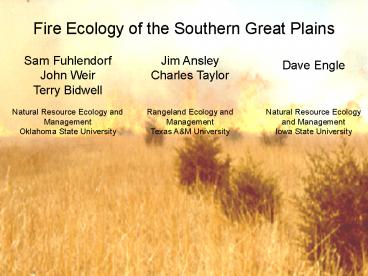Fire Ecology of the Southern Great Plains - PowerPoint PPT Presentation
1 / 40
Title: Fire Ecology of the Southern Great Plains
1
Fire Ecology of the Southern Great Plains
Jim Ansley Charles Taylor Rangeland Ecology and
Management Texas AM University
Sam Fuhlendorf John Weir Terry Bidwell Natural
Resource Ecology and Management Oklahoma State
University
Dave Engle Natural Resource Ecology and
Management Iowa State University
2
Southern Great Plains
http//gisdata.usgs.net/website/MRLC/viewer.php
3
Southern Great Plains Outline
- Fire Sensitive Trees Ashe Juniper and Eastern
Redcedar - Resprouting Shrubs and Trees Shinnery oak, Sand
sagebrush, Plum, Sumac, Mesquite, Live Oak, Post
Oak - Grasslands- Tall-, Mixed- Short-grass Prairies
- Controlling factors of fire effects
4
Fire Sensitive Trees
http//gisdata.usgs.net/website/MRLC/viewer.php
5
(No Transcript)
6
(No Transcript)
7
Historical Stocking Rate Decline Sonora
Experiment Station
160
140
120
100
Animal Units/Section
80
60
40
20
0
1900
2020
1950
2000
Year
8
Patch Dynamics
Weather Patterns
Herbaceous Biomass
Grazing
Landscape Dynamics (Fuhlendorf et al. 1996)
Fire Intensity
Juniper Size and Density
Seed Dispersal
Fire Frequency
Seed Production
Mortality
Fuhlendorf et al. 1996 Fuhlendorf et al. in review
9
Ungrazed and No Fire
Potential Herb. Biomass
Remaining Herb. Biomass
Tree Density
10
Ungrazed with a 10 year fire frequency
11
Timing of the first fire is critical
No Grazing with a 10 year fire frequency Biomass
Remaining after 150 years
100
X
X
75
50
Biomass Remaining ()
X
25
X
0
Year 10
Year 20
Year 30
Year 40
Year of first fire
12
Fire-sensitive woody plantsSummary
- Ashe Juniper on Low Prod. site (Sonora TX)
- Without fire, JUAS dominance in about 60 yr
- Without grazing 15 year fire return interval
- Moderate grazing 5 year fire return interval
- Heavy grazing sell the farm? or extreme fire
- Eastern Redcedar -High Prod. site (Stillwater OK)
- Without fire, JUVI dominance in about 45 yr
- Without grazing 10 year fire return interval
- Moderate grazing 10 year fire return interval
- Heavy grazing 2-3 year fire return interval
13
Resprouting shrubs and trees
http//gisdata.usgs.net/website/MRLC/viewer.php
14
Oak savanna annual burn
15
Photo by John Weir
16
(No Transcript)
17
Fire Frequency on Tallgrass Prairie Rhus glabra,
Cornus durmmundii, Prunus americana
Briggs et al. 2005
18
Cross Timbers of Texas, Oklahoma Kansas Without
fire
19
3-yr fire return interval
4-yr fire return interval
2-yr fire return interval
1-yr fire return interval
Photo by John Weir
20
5 year burn frequency
2 year burn frequency
No burn- control
Photo by John Weir
21
Photos by Jim Ansley
22
Regrowth 10 years after fire
23
(No Transcript)
24
Resprouting shrubs and trees Summary
- Temporary increase in herbaceous dominance
- Minimal negative effect (if any) on density
- Management with fire requires high frequency
(e.g. 2-5 year return interval).
25
Grasslands
http//gisdata.usgs.net/website/MRLC/viewer.php
26
(No Transcript)
27
(No Transcript)
28
Bison Unit of the Tallgrass Prairie Preserve
End of year standing crop (g 0.10 m-2)
29
Transient Maxima Hypothesis
Blair 1997
30
Ansley et al. 2006
31
(No Transcript)
32
Season has minimal longterm effects in grasslands
- Howe 1994
- Engle et al. 2000
- Engle and Bidwell 2001
- Brockway et al. 2002
- Towne and Kemp 2003
- Fuhlendorf and Engle 2004
- Fuhlendorf et al. 2006
- Ansley et al. 2006
33
Pre-fire Condition
1 Month Post-fire
1 Year Post-fire
Photos by Jim Ansley
34
GrasslandsSummary
- Reduce woody plant encroachment
- Alter grazing distribution to provide
heterogeneity - Short term, stochastic effects on composition
- Interaction with weather
- Frequency and season have less effect than time
since fire.
35
Factors that influence fire effects
- Everything that influences fire intensity
- Fuel load, humidity, temperature, Fuel moisture
etc.. - Grazing
- Season
36
Photos by Jim Ansley
37
Effect of Summer Fire
100
80
Scorch proportion ()
60
40
Fuel Moisture gt 20 r2 0.876 P lt 0.01
20
0
0
100
200
300
400
500
Mean fuel load (g m-2)
Twidwell, Fuhlendorf Engle in review
38
Factors that influence fire effects
- Everything that influences fire intensity
- Fuel load, humidity, temperature, Fuel moisture
etc.. - Grazing
- Season
- Fire Frequency / Time Since Fire
39
Summary and Synthesis
- Focus on woody-herbaceous interaction
- For Fire Sensitive species
- Fire interval 5-15 yr
- Grazing and initial conditions are critical
- For Re-sprouting Species
- Fire interval 2-5 yrs
- For Grasslands
- Time since fire
- Critical issues
- Fire intensity
- Time since fire
40
Rx Fire Associations
- Cooperation among landowners
- Rural fire departments
- Go beyond ownership boundaries
- Can limit liability
- Create a new land ethic
- Provide training































